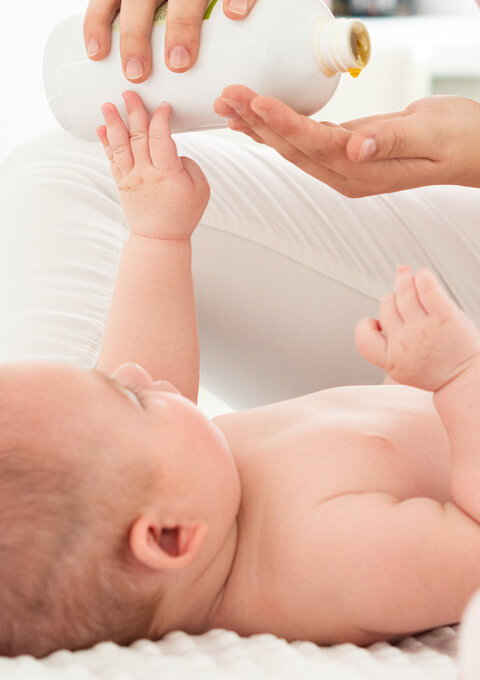Learn about Shantala baby massage and its benefits by reading this article.
Expert consultant: Danuta Chrzanowska - Liszewska, MD, paediatric specialist and neonatologist
Shantala massage is an ancient form of infant massage that can be performed by parents. It is not a rehabilitation procedure, and after a short training, you will be able to perform it yourself. However, it is important to note that Shantala baby massage is not recommended for infants with skin lesions, cardiac problems, asthma, or a fever. Additionally, it is important not to massage your baby immediately after feeding or vaccination.
Shantala massage has a soothing effect on the baby. The infant calms down, relaxes, and feels safe and secure with the active presence of the parent. The rhythmic exercises stimulate the baby's body and promote better development. Body awareness increases in the baby being massaged what leads to fewer sleep problems. Massage has a positive effect on the digestive system, prevents colic, stimulates the immune and hormonal systems, and fosters a special bond between the child and parent.
Additionally, Shantala massage has a positive effect on the mother. It can calm her, relieve symptoms of postnatal depression, increase self-confidence, facilitate understanding of the baby, and strengthen the relationship between her and her child.
You can easily perform the massage yourself, but it is important to first learn the proper technique. The best way to learn Shantala massage is by signing up for a class, where a professional will explain everything and guide you step-by-step. If attending an in-person class is not an option, there are plenty of online tutorials and lessons available.
Choose a room with a comfortable temperature, as your baby should be warm and undressed during the massage. It is also important to choose the right time and avoid massaging the baby soon after feeding. Prepare a suitable space by laying a soft blanket and having baby oils nearby.
Sit in front of the baby, and place the baby on the blanket on your lap so that their legs are resting on your stomach. Alternatively, you can also lay the baby on the ground, on a mat or on a changing table. It is crucial that the baby is close to you during the massage.
Warm up your hands before starting the massage. During the massage, try to keep your hands on the baby's body at all times and avoid pulling them away. Gently massage all parts of the baby's body in a set order: chest, shoulders, hands, tummy, legs, joints of the feet, feet, back, and finally the face.
When massaging the chest, start from the centre, move up the ribs, and along the sides, then continue towards the shoulders, and finish with a movement from the hips up towards the opposite shoulder.
While massaging the shoulders, start with circular motions using your thumbs, and finish with the whole hand. Use your thumb and forefinger to massage the wrists. Gently smooth the baby's tummy from the ribs to the groin, lift the baby's legs, and then massage the tummy itself. Massage the legs in circular motions, starting from the groin downwards and finally massage the joints of the feet.
For the back, start massaging from the neck downwards and then vice versa, from the bottom upwards. Towards the end, massage the baby's bottom and legs. To start the face massage, gently apply pressure to the centre of the forehead, moving towards the temples. Then, move towards the nose and up again to the eyebrows. Finally, go down, massaging the nose towards the corners of the mouth.
Stop the Shantala massage if your baby becomes impatient or restless. The massage should be a pleasant experience for both you and your little one.
The entire massage should take about 5-10 minutes and can be done in the morning or evening, 3 to 4 times a week. After the massage, give your baby a bath to cleanse any oils off their skin.
You have just given birth. You look at yourself in a mirror and see rolls of fat on your hips, loose stomach muscles and stretch marks. It is natural, as nine months of pregnancy change woman's body.
Sleeping together with a baby has its ardent supporters and opponents. Regardless of your choice, whether you put the baby in his room, place his cot in your bedroom, or take the baby into your bed, it will have consequences ...
ivorce is most painful when divorcing people are not only spouses but also parents. It is impossible to conduct it in a way completely not affecting the child. However, together you can do everything possible to reduce his ...
